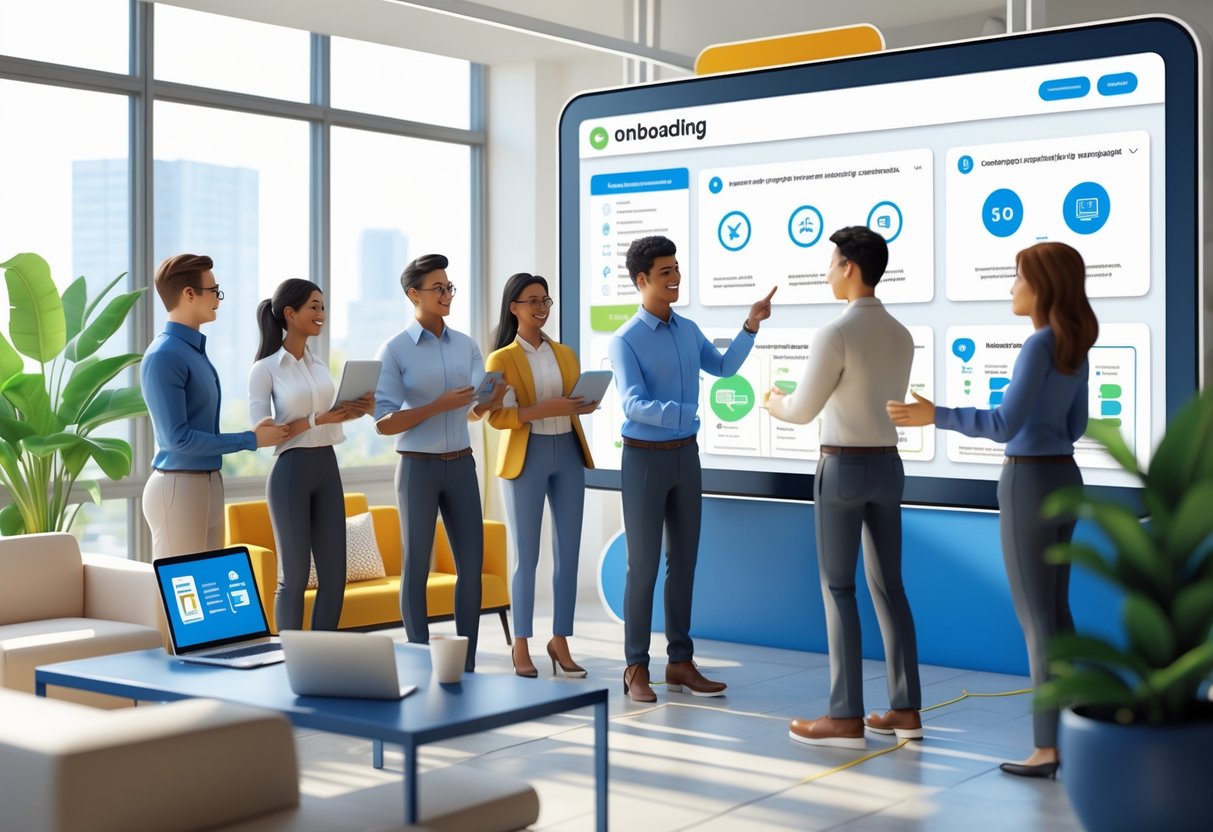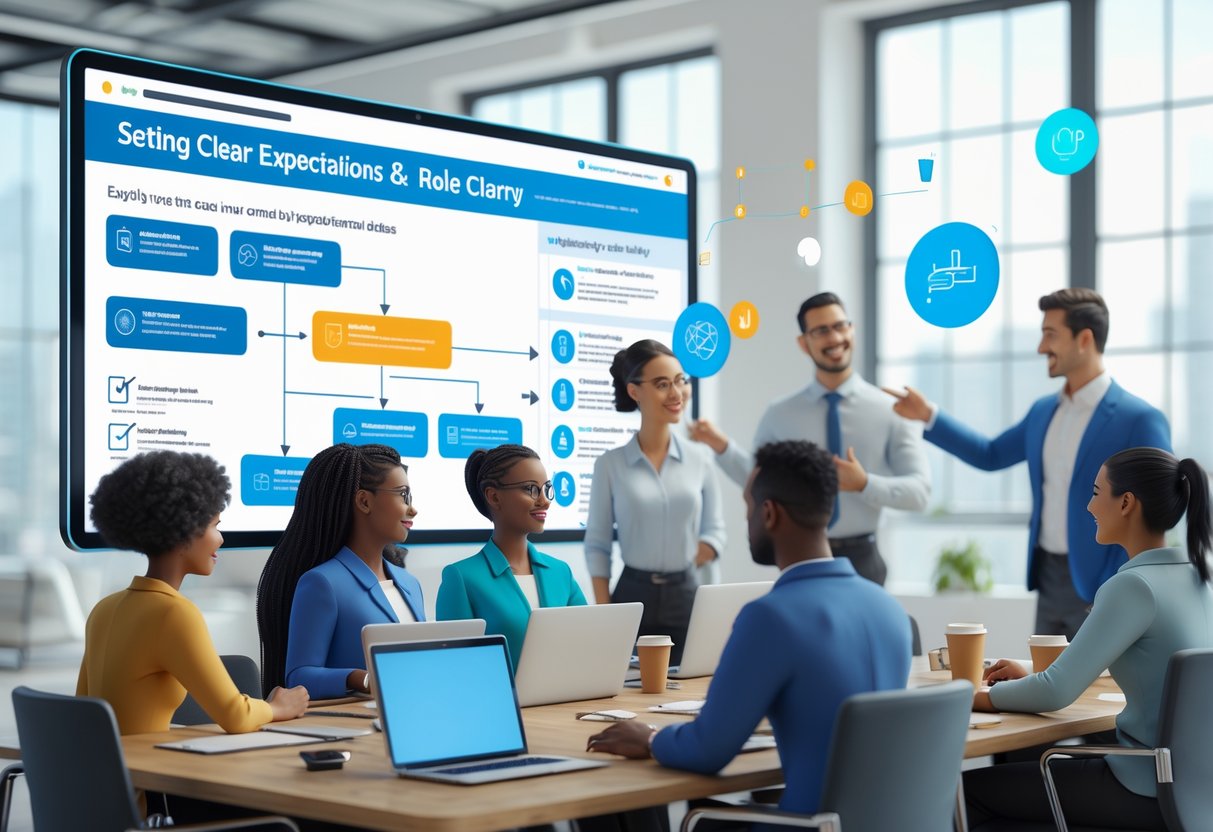Onboarding Improvements: Practical Strategies for Lasting Impact
Updated On: October 23, 2025 by Aaron Connolly
Core Principles of Onboarding Improvements
When you focus on onboarding improvements, you end up transforming how people experience their first months at your company. It’s about making sure every new hire feels supported, productive, and honestly, like they’re part of something meaningful from the very first day.
Benefits of Enhancing the Onboarding Experience
If you take the time to improve your onboarding, the payoff is pretty obvious. Companies that actually put effort into structured onboarding see retention rates jump by as much as 82%. That’s huge compared to places that just run a quick orientation and call it a day.
Productivity jumps too. New hires in solid onboarding programs get up to speed about 70% faster than folks who go through the bare minimum. So, you’re not just investing in a feel-good process—it actually pays off within a few months.
Here’s what you get with better onboarding:
- Lower turnover costs (since replacing someone can burn through 33% of their salary)
- Quicker ramp-up for new team members
- Higher job satisfaction and employee engagement
- Stronger cultural fit and team bonds
Onboarding really does affect your bottom line. Around 20% of new hires leave in their first 45 days, so if you want to stop that churn, this is where you start.
From Orientation to a Full Onboarding Programme
Orientation usually means paperwork and a crash course in company policies. It’s often just a day, maybe two, and then you’re on your own. But onboarding? That’s a different animal.
A proper onboarding program stretches out over 12 months. You get four phases: preboarding, orientation, training, and integration. Each one helps new hires settle in and actually thrive.
Here’s how they stack up:
| Orientation | Full Onboarding Programme |
|---|---|
| 1-2 days max | 3-12 months long |
| Just paperwork and policies | Real cultural integration and relationship-building |
| One-size-fits-all | Tailored to the role and the person |
| Only HR runs it | Multiple departments involved |
Instead of just dumping info on new hires, we actually help them succeed. That means mentorship, regular check-ins, and ongoing skill-building. It’s about giving people the confidence and connection they need.
Key Goals for Effective Onboarding
We want our onboarding to hit four main goals so new hires actually succeed. Each one builds up a real support system.
First, help people build competence and confidence fast. Early wins matter. We set up initial projects that are doable but still challenging, so new hires can show what they’ve got right away.
Next, foster real connections. Skills are important, but so is feeling like you belong. Pairing new hires with buddies and creating chances for casual chats makes a big difference. People who make friends at work stick around longer.
Then, clear up any confusion about roles and expectations. If people don’t know what’s expected, they flounder. We set 30, 60, and 90-day milestones so everyone’s on the same page. Regular feedback keeps things on track.
Last, embed the culture. Company culture isn’t just a poster on the wall. We share stories, show what matters, and explain the unwritten stuff. That way, new hires aren’t left guessing how things really work.
Designing a Structured Onboarding Process
You need a clear timeline, a practical checklist, and solid training modules. These three things keep new hires moving forward from day one to full productivity.
Creating a Customised Onboarding Timeline
Week 1: Foundation Setting
Start with the basics for their role, not just general company stuff. Let new team members meet their coworkers, get comfy in their workspace, and jump into hands-on tasks right away.
Week 2-4: Skill Building
Now’s the time for department-specific training. Cross-training with other teams helps new hires see how their job fits into the bigger picture.
30-60-90 Day Milestones
Set clear checkpoints. At 30 days, check for basic skills. At 60, see if they’re working independently. By 90 days, they should feel fully integrated.
Timeline Flexibility
Not every job moves at the same pace. Technical roles might need longer upfront, but customer-facing positions often benefit from getting into real work sooner.
Building an Onboarding Checklist
Pre-boarding Essentials
- Set up equipment and accounts
- Send a welcome packet with first-day info
- Introduce their manager by email
- Get initial paperwork done
First Day Requirements
- Give a workspace tour and introduce key people
- Go over safety and emergency procedures
- Walk through tech setup and passwords
- Assign their first project
Weekly Progress Items
Focus on tracking skills, not just time. Look for tool proficiency, understanding of processes, and how well they’re meshing with the team.
Documentation Standards
Each checklist item should have clear criteria and who’s responsible for it. That way, nothing slips through the cracks and everyone gets the same experience.
Mapping Out Structured Training Modules
Core Competency Modules
Break training into small, focused chunks. Keep each module to 2-3 hours to avoid overload and keep people engaged.
Progressive Learning Path
Start with the basics, then build up. Module 1: simple processes. Module 2: tools and systems. Module 3: more advanced stuff.
Interactive Elements
Make training hands-on. Let new hires shadow peers and work on real projects. Passive slideshows just don’t cut it—people learn best by doing.
Assessment Checkpoints
Add quick checks after each module. The goal isn’t to trip people up, just to make sure they’re actually getting it before moving on.
Module Customisation
Tweak content for experience level and role. Senior hires can skip the basics, but juniors might need the full run-through.
Preboarding: Setting the Stage for Day One

Preboarding happens after someone signs their contract but before they walk in the door. By keeping in touch, handling paperwork early, and sharing your culture, you keep new hires excited—and way less likely to bail before day one.
Communicating with New Employees Pre-Start
Regular contact during preboarding keeps people pumped to join. Shockingly, 64% of new hires never get any preboarding, so they end up feeling forgotten.
Send a welcome email within a day of contract signing. Include their start date, what to wear, and maybe even a short video from their manager.
Lay out a simple timeline for what comes next:
| Week Before Start | Actions |
|---|---|
| 2-3 weeks out | Welcome email and paperwork |
| 1 week out | Team intros and agenda |
| 2-3 days out | Last check-in and reminders |
Set up a quick virtual coffee chat with future teammates. It helps break the ice before their first day.
Make sure you’re reachable for questions. Give out HR and manager contact info. Fast replies show you care about their decision to join.
Completing Paperwork and Compliance Early
Get the admin stuff out of the way before day one. Tax forms, handbooks, benefits—all that can happen in advance.
Don’t dump every document on them at once. Start with the essentials:
- Contracts and legal docs
- Tax and national insurance forms
- Bank details for payroll
- Emergency contacts
Set up automated reminders for anything that needs a signature. Give clear deadlines but don’t rush people.
Use digital tools like DocuSign to keep things simple, especially for remote hires.
Share the employee handbook early. Cover policies, benefits, and workplace basics so folks have time to read it all.
Introducing the Company Culture Remotely
Help new hires get a feel for your workplace culture before they step in. This lowers first-day nerves and helps them fit in quicker.
Put together a simple guide that covers:
- Core values and how they show up day-to-day
- How people communicate (formal emails or just Slack?)
- Meeting habits and what’s normal
- Social stuff and team traditions
Share photos of the office, events, and regular workdays. Remote or hybrid hires really appreciate seeing what things look like.
Invite them to sit in on a team meeting during preboarding. Let them listen in, even if they stay muted, just to see how the team works.
Pair them with a buddy before their first day. Pick someone approachable who can answer all the little questions.
Send over a team directory with photos and a quick blurb about who does what. That way, first-day introductions aren’t so awkward.
Welcoming and Integrating New Hires
How you welcome new team members shapes their whole experience. Strong first impressions, real mentorship, and thoughtful team introductions help new hires connect and build meaningful relationships right from the start.
Creating a Warm First Impression
The first day matters—a lot. Prep their workspace before they arrive, with all the equipment ready and a handwritten note from their manager.
Little things count. Have their computer set up, software installed, and logins ready. Leave a welcome pack with company swag, an org chart, and maybe a list of good lunch spots.
You’ll want to cover these basics:
- A clean desk ready to go
- Welcome email sent ahead with parking and dress code info
- Lunch scheduled with their manager
- Quick tour and intros to key people
Take away as much uncertainty as possible. When people feel prepared and genuinely welcomed, they can focus on learning—not worrying about where to find the bathroom.
New hires who get a structured welcome report 40% higher job satisfaction in their first month. That’s not a small thing.
Office Buddy and Mentorship Initiatives
Pairing new hires with experienced coworkers gives them instant support and speeds up cultural integration. Assign an office buddy in week one, but pick someone outside their direct team so it feels more relaxed.
Buddies help with the little stuff—finding the best coffee, decoding office quirks, and figuring out how things really work. This shouldn’t feel forced.
Good buddy programs:
- Match people by interests, not just department
- Set up weekly check-ins for the first month
- Give basic guidelines for both work and social stuff
- Collect feedback and tweak the program as needed
Mentors handle the bigger picture—career growth and skills. Usually, they’re more senior and help with development goals and strategy.
Structure mentorship with monthly meetings and set clear goals. Having both a buddy and a mentor covers both immediate needs and long-term growth.
Team Introductions for Cultural Integration
Smart team introductions show new hires how everything fits together. Schedule short meetings with key players in the first two weeks.
Keep these chats casual. Let new hires hear about each team’s role and current projects, and see how they’ll work together. This heads off confusion and helps build relationships early.
Here’s a simple intro plan:
- Week 1: Direct teammates and close collaborators
- Week 2: Cross-functional partners and support teams
- Month 1: Senior leaders and wider connections
Encourage informal meetups—team lunches, coffee breaks, or joining social events. These help people settle in naturally.
Let new hires sit in on team meetings at first, just to watch. As they get comfortable, they can jump in more actively and really become part of the team.
Delivering Engaging and Effective Training
If you want onboarding to stick, you’ve got to blend hands-on experiences with digital tools. That’s how you boost retention and keep people interested.
New hires crave role-specific content, not some one-size-fits-all program. Compliance training needs extra care so you meet legal standards—without boring everyone to tears.
Blending Hands-On and Digital Learning
The best onboarding mixes face-to-face mentoring with digital modules. Start with some short video tutorials that new hires can check out before day one.
Digital First, Practice Second
Kick things off with 10-minute microlearning videos about company basics. After that, give new hires a chance to shadow experienced colleagues and get their hands dirty.
With this flipped classroom style, in-person time becomes all about practicing real skills. No more endless info dumps.
Mobile-Friendly Reinforcement
Make sure key resources and quick guides are easy to access on mobile. New hires can sneak in a review during a break or even on the train.
Try spaced learning too—send out brief weekly check-ins through your learning system. It helps fight that inevitable knowledge decay and keeps the essentials fresh.
Role-Specific Training Plans
Generic training just doesn’t cut it. Every role needs its own path. Sales folks need customer interaction training, while developers require technical onboarding.
Customised Learning Pathways
Build separate tracks for each department. Marketing hires should get brand guidelines and campaign tools, while finance staff need compliance and software training.
| Role Type | Training Focus | Duration |
|---|---|---|
| Sales | Product demos, CRM systems | 2 weeks |
| Technical | Development tools, code standards | 3 weeks |
| Customer Service | Communication skills, support systems | 1 week |
Progressive Skill Building
Start with the basics—the stuff new hires actually need in week one. Add more advanced skills over the first 90 days.
Get them working on real projects with a supervisor’s support. It’s a confidence boost, and they’ll deliver real value faster.
Compliance Training Essentials
Let’s be honest, compliance training is rarely fun. But it’s necessary, and you can make it better.
Interactive Scenarios
Swap out endless policy docs for real-life workplace situations. Give learners choices and let them see what happens.
For example, data protection training works way better when employees face actual email security dilemmas instead of reading a privacy policy.
Ongoing Reinforcement
Don’t wait for the annual compliance marathon. Schedule short refreshers each quarter. Toss in gamification elements like badges and progress bars.
Documentation Requirements
Track who completes which modules using your LMS. Keep tabs on dates and quiz scores for audits.
So many companies get in trouble because they can’t prove employees finished training. Automated tracking saves you from that mess.
Supporting Employee Engagement Throughout Onboarding

If you want new hires to feel like they belong, you need structured manager interactions, team-building activities, and ways for people to connect. These pieces fit together to create a welcoming vibe from the start.
Regular One-on-One Time with Managers
Set up weekly check-ins for the first month. These should focus on real goals and challenges, not just small talk.
Consistent feedback helps new hires adjust. Managers can spot concerns early and fix them before they grow. Studies say employees who get regular feedback are 30% more likely to stay engaged.
Key topics for one-on-one sessions:
- Progress on training milestones
- Questions about company processes
- Career development chats
- Support for workload and time management
Great managers take notes during these talks. They look for patterns across hires and use that info to tweak onboarding down the line.
Facilitating Onboarding Activities
Planned onboarding activities help people bond and learn at the same time. Don’t just hand out paperwork—mix in real experiences.
Try these:
- Team intros where staff share what they do
- Department shadowing so new hires see how teams connect
- Project-based learning that lets new employees contribute right away
Make it interactive. People remember experiences, not lectures. Practicing skills in a safe space does wonders for confidence.
Timing matters. Spread activities out over two weeks. Don’t cram everything into day one—you’ll just overwhelm folks and kill momentum.
Building Early Connections
Peer mentorship speeds up relationship building. Assign a buddy so new hires have someone to ask those “dumb” questions without bugging the boss.
The best peer bonds form naturally through shared projects. Working side-by-side on real tasks beats awkward intro meetings every time.
Social integration ideas:
- Lunches with different team members
- Casual coffee chats
- Team events during month one
- Introductions across departments
These little connections fight that lonely new-hire feeling. They build a support network that lasts. Honestly, employees with workplace friendships just stick around longer.
Setting Clear Expectations and Role Clarity

New team members need to know exactly what’s expected and how their role fits in. That means giving them detailed job descriptions, setting clear performance targets, and building feedback systems that keep everyone on track.
Providing Detailed Job Descriptions
Let’s give new hires job descriptions that actually help. Forget vague bullet points—lay out daily tasks, weekly responsibilities, and monthly goals.
Must-haves for a good job description:
| Component | What to Include | Why It Matters |
|---|---|---|
| Role Overview | 2-3 sentences explaining the position’s purpose | Shows new hires their impact |
| Daily Tasks | List of daily activities | Removes guesswork about priorities |
| Reporting Structure | Who they report to and who reports to them | Clarifies who to talk to |
| Success Metrics | How you’ll measure performance | Sets clear targets from day one |
Explain how their role links up with team and company goals. People work harder when they know why their job matters.
Quick win: Make a role clarity checklist for week one. Stuff like “I know my daily priorities” and “I know who to ask for help.”
Clarifying Performance Benchmarks
Set specific, measurable expectations right away. If you want new employees to succeed, show them what success looks like.
Break down benchmarks by timeframe:
- 30 days: Master basic systems, finish a first project
- 60 days: Handle tasks solo, meet quality standards
- 90 days: Hit full productivity and contribute to team goals
Give examples of great work. Spell out what “good enough” and “exceptional” look like.
Heads up: Ditch vague stuff like “be proactive.” Instead, say “spot problems before they cause delays” or “suggest improvements during meetings.”
Write down these benchmarks and review them in early one-on-ones. It keeps everyone on the same page and stops confusion later.
Ongoing Feedback and Support
Regular check-ins keep new employees moving forward. Schedule some formal feedback but also let people ask questions anytime.
Feedback structure:
- Weekly one-to-ones for the first month
- Bi-weekly meetings for months two and three
- Monthly check-ins after probation
Ask pointed questions about clarity. Instead of “How’s it going?”, try “Which parts of your job still feel fuzzy?” or “What tasks are taking longer than you expected?”
Assign a buddy or mentor for everyday questions. Sometimes people just need a safe space to say, “I’m lost.”
Quick win: Use a simple weekly feedback form. Ask about workload, instructions, and support needs. It’s a great way for quieter folks to raise issues.
Encouraging Career Growth from the Outset

Bringing up career conversations during onboarding shows new hires they have a future here. You can outline development paths and talk about growth opportunities from day one.
Aligning Onboarding with Career Goals
Find out what each new hire wants from their career. Have real conversations about their goals in week one.
Ask questions like “Where do you want to be in two years?” and “What skills are you hoping to build?” Write down their answers and use them to personalize onboarding.
Build development plans that tie daily work to bigger career goals. If someone’s eyeing management, point out leadership chances in their current role.
Set up goal-tracking early. Use tools like:
- Monthly manager check-ins
- Simple skills assessments
- Career pathway docs
- Progress tracking sheets
This stuff makes people feel like you care. It’s not just a hunch—research backs it up. Employees who talk about career goals early tend to stick around.
Discussing Development Opportunities
Don’t wait months to mention growth opportunities. New hires need to know what’s out there right away.
Show them a menu of options:
| Development Type | Timeline | Cost to Employee |
|---|---|---|
| Internal training courses | 3-6 months | Free |
| External certifications | 6-12 months | Company-funded |
| Mentorship programmes | Ongoing | Free |
| Cross-department rotations | 12-18 months | Free |
Tell them how to get started. Give out contact names and application steps.
Introduce mentorship during onboarding week. Pair new hires with experienced colleagues who can guide their growth.
Be upfront about performance reviews and promotion timelines. Let folks know what advancement really looks like and how long it usually takes.
When people know the path, they plan better—and they’re more likely to stick with you.
Overcoming Common Onboarding Challenges

New hires run into predictable roadblocks that can throw off their early days. The big ones? Information overload, turnover triggers, and retention headaches. Luckily, you can tackle these with the right strategies.
Reducing Information Overload
Information overload is a classic onboarding headache. Too many companies dump piles of documents and policies on new hires in week one—with no sense of priority.
Break training into small chunks over 30, 60, and 90 days. Focus week one on just the essentials. Save company history and detailed policies for later.
Build role-specific learning paths instead of generic orientations. A marketing hire needs different info than an engineer right out of the gate.
| Week Focus | Marketing Role | Engineering Role |
|---|---|---|
| Week 1 | Brand guidelines, key campaigns | Development environment, coding standards |
| Week 2 | Customer personas, competitor analysis | Team workflows, project management tools |
| Week 3 | Campaign metrics, reporting tools | Architecture overview, deployment processes |
Lean on interactive training instead of endless reading. Pair new hires with experienced teammates for hands-on sessions.
Check in regularly to see what’s sticking. Ask about specific training topics, not just “How’s it going?”
Addressing High Turnover Causes
High turnover during onboarding usually comes from unmet expectations and poor cultural fit. We need to spot and fix these friction points early.
Set realistic job expectations right from the interview and reinforce them during onboarding. Let’s not oversell responsibilities or growth.
Tackle isolation fast by helping new hires build social connections. Assign peer mentors—not just supervisors—so new folks can figure out the informal stuff.
Give regular feedback in the first 90 days. Don’t just wait for formal reviews to address issues or celebrate wins.
Common turnover triggers:
- Unclear roles
- No manager support
- Missing tools or resources
- Poor team fit
- Overwhelming workloads
Watch leading indicators like training completion rates, how often peers interact, and early performance numbers. These warn us about turnover risk before someone actually leaves.
Improving Retention Rates
Improving retention means we have to keep supporting new hires well past onboarding. A structured approach helps extend support through the first year.
Schedule milestone check-ins at 30, 60, and 90 days. Use these to tweak training and tackle any new concerns.
Show clear career paths from day one. Let new hires see real examples of others who moved up from similar roles.
Measure onboarding effectiveness with retention rates and feedback surveys. Track how long it takes for people to hit full productivity.
Personalize the process for each person’s learning style and goals. Some folks love checklists, others want to explore a bit.
Keep the connection alive after onboarding. Regular manager meetings, peer groups, and learning opportunities matter. The relationship doesn’t just stop after 90 days.
Evaluating Success: Measuring Onboarding Improvements

The key to improving your onboarding program? Measure it. Use targeted surveys, performance metrics, and keep updating the program. These three create a feedback loop for real change.
Gathering Onboarding Survey Feedback
Employee satisfaction surveys give us the most direct insight. Run them at three big moments: 30, 60, and 90 days after someone starts.
The 30-day survey should focus on first impressions and setup. Ask things like, “Did you get all your equipment on day one?” or “Were your job duties clear after week one?”
At 60 days, focus more on skill development and fitting in. Ask if they feel ready for their role and connected to the team.
Anonymous feedback usually gets more honest answers. But mixing in named feedback works too. Go anonymous for candor, then follow up for individual support.
Key survey topics:
- Training quality
- Manager support
- Resource access
- Cultural fit
Using Metrics to Track Progress
Employee retention tells us if onboarding works. Track how many new hires stay after six months and a year.
Time-to-productivity shows how fast people get up to speed. Define milestones for each job and see how quickly folks hit them.
Performance metrics to track:
- Training completion
- First-month performance
- Time to handle key tasks solo
- Team workflow integration
We check these monthly and compare to industry numbers. If your 90-day retention drops below 85%, your onboarding needs help.
Create dashboards to show these metrics. It’s easier to spot trends and share updates with leadership.
Continuous Iteration of the Onboarding Programme
Keep onboarding fresh by updating it regularly. Review feedback every quarter and make changes based on clear patterns.
Typical improvements include cutting down info overload, clarifying roles, and boosting cultural activities.
Best practices:
- Test changes with small groups
- Document what works and what doesn’t
- Update training materials often
- Get manager feedback on new hire readiness
Focus groups with recent hires offer insights you won’t get from surveys alone. They’ll point out pain points and suggest fixes.
Track the impact of every change. If training completion jumps after a tweak, you know it worked.
Best Practices for Remote and Hybrid Onboarding

Remote and hybrid work mean we have to adapt the onboarding process. Success hinges on clear communication and tailoring support for distributed teams.
Adapting Processes for Remote Staff
Pre-boarding is critical for remote hires. Ship welcome kits and gear 3-4 days before they start. It builds excitement and ensures they’re ready.
Tech setup needs extra attention for remote folks. Provide easy-to-follow guides for connecting to systems and apps. A Digital Adoption Platform can walk them through each tool—most new hires need to learn over 11!
Virtual intros replace office tours. Book 15-minute video calls with key team members in week one. Try virtual coffee breaks or online games to help people bond.
Structured check-ins stop isolation. Book formal meetings at 30, 60, and 90 days. In between, have informal chats to catch issues early.
Ensuring Consistent Communication
Set up clear communication channels from day one. Create dedicated Slack or Teams channels so new hires can ask questions without feeling like a bother. Assign contacts for different topics.
Use standardized message templates for onboarding. That way, everyone—remote or in-office—gets the same info about policies and benefits. Consistency builds trust.
Document everything. Remote workers can’t just tap someone on the shoulder. Offer guides, video tutorials, and FAQs for daily processes.
Schedule regular one-on-ones with managers during the first month. These chats should go beyond tasks—check how new hires feel about the culture and their team.
Sustaining Long-Term Productivity and Retention

Building strong connections and keeping performance high doesn’t stop when training ends. Companies that invest in ongoing support see 82% higher new hire retention and longer-lasting productivity.
Strengthening Connections Beyond Onboarding
The first 90 days set the tone, but real connections need ongoing work. Regular check-ins make a big difference for engagement.
We suggest monthly one-on-ones between new hires and managers. These meetings surface concerns before they grow into bigger issues.
Peer mentorship programs help build lasting bonds. Pair new hires with experienced teammates for at least six months. This helps them learn the culture and build a network.
Team integration works best when it’s consistent. Weekly lunches or quarterly events keep those initial connections alive.
Start career talks early—within the first three months. People want to see a future. Lay out paths for advancement and revisit them often.
Feedback loops matter well past probation. Monthly pulse surveys catch engagement issues before they affect retention.
Maintaining Employee Productivity
Ongoing training and clear expectations keep productivity high. Companies that build continuous learning from day one see the best results.
Track skills development after initial training. Use learning platforms to monitor progress and spot gaps early.
Schedule performance reviews at 3, 6, and 12 months—don’t just wait for annual check-ins.
Set goals that matter. Break annual targets into quarterly wins that match business needs.
Make resources easy to find. Ensure new hires know where to access training, tech help, and development opportunities.
Recognition matters for long-term performance. Celebrate achievements at 6 and 12 months to reinforce good habits.
Support for new tech prevents productivity dips. Keep training coming when you roll out new tools or updates.
Frequently Asked Questions

Here are answers to the most common questions about improving onboarding. We cover practical tips like checklists, gathering feedback, and proven strategies.
What are the key components of an effective onboarding checklist?
A good onboarding checklist starts before day one. Send welcome packages, finish paperwork online, and set up their workspace with badges and passwords.
The checklist should outline goals and tasks for day one, week one, month one, and three months.
On the first day, include office tours, team introductions, and maybe a welcome lunch. Week one is about basic training and assigning a buddy.
Month one should offer job shadowing and gradual work assignments. By three months, schedule formal feedback and role clarity talks.
Don’t forget admin stuff—tax forms, direct deposit, and handbook acknowledgements need their own section.
How can we gather and utilise feedback to enhance the onboarding experience?
Timing matters for feedback. Survey new hires after day one, week one, month one, and three months.
Ask straightforward questions. Focus on role clarity, team fit, and training.
Mix rating scales with open-ended questions for both data and detail.
Companies like Google and Microsoft use short surveys—less than 10 questions—to boost responses.
Feedback from current employees helps too. They’ll spot gaps new hires might miss.
Act on feedback quickly. Share changes so people see their input matters.
Could you share some examples of the best practices in employee onboarding?
The best companies start onboarding before day one. They send swag, finish paperwork online, and get workspaces ready.
Buddy systems help new hires feel welcome. Pair them with positive teammates who aren’t their managers.
Job shadowing lets new employees see other departments and builds connections.
Make the first day fun, not just paperwork. Plan a team lunch, send intro emails, or give a small gift.
Ease people in with gradual tasks—set goals for three, six, and nine months.
Get senior leaders involved. Execs can give tours, host lunches, or run training.
What is the role of HR in ensuring a smooth onboarding process?
HR runs the onboarding timeline. They handle pre-boarding, paperwork, and scheduling.
They create and update onboarding checklists for every role.
HR trains managers and team members on their responsibilities. They provide templates and tips for good integration.
They collect and study onboarding feedback, spot trends, and drive improvements.
Compliance is another big job. HR makes sure all legal boxes get checked.
They also set up regular check-ins and tackle any issues that pop up.
What suggestions might you have for improving our onboarding procedures?
Start by surveying recent hires. Ask what confused them and what made them feel welcome.
Check your timeline. Many companies rush onboarding, but three to six months works better.
Get more team members involved. Don’t leave it all to HR and managers.
Build role-specific onboarding paths. Different jobs need different training.
Use tech to cut admin headaches. Digital forms and reminders help.
Measure success with retention and early performance. Track what parts of onboarding actually help long-term.
Stay flexible. Remote hires and different personalities need different approaches.
Where can I find a comprehensive guide to new employee onboarding?
Plenty of professional HR organizations share detailed onboarding frameworks. The Society for Human Resource Management, for example, offers templates and some pretty solid best practices.
Honestly, industry-specific resources usually beat out generic guides. Try to find onboarding advice that actually fits your business sector.
Employee experience platforms dig up research and benchmarking data. You can see how your onboarding process stacks up against similar companies.
Business publications like Forbes and Harvard Business Review often feature onboarding case studies. These sources highlight strategies that have actually worked.
A lot of HR software providers add implementation guides, too. They mix best practices with hands-on technology tips.
If you’re planning a big overhaul, you might want to hire onboarding consultants. They’ve seen what works across different companies and industries.








